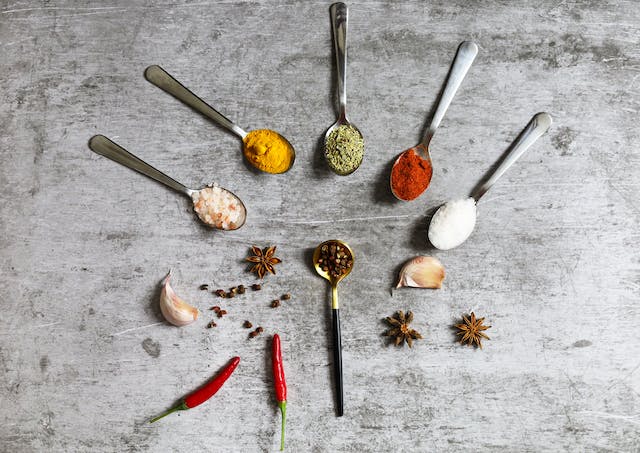Tablespoons and teaspoons measure smaller amounts of ingredients like spices, oils, and vanilla extract. Imagine trying to measure a tiny amount of vanilla extract on a scale—it would be tricky! These units are like the superheroes of the kitchen because they help when things are too small to measure in cups or too fiddly to weigh.
In cooking and baking, tablespoons and teaspoons are super important. They’re like the mini-measurement champions that work in both the metric and imperial systems. You’ll often see recipes calling for a teaspoon of this or a tablespoon of that. They’re like the secret agents behind delicious recipes, ensuring just the right amount of flavour goes into your dishes.
Using these measurements helps you get your recipes just right. Think about adding a pinch of salt or a splash of oil – that’s where tablespoons and teaspoons step in. They’re like the trusty sidekicks making sure your culinary creations turn out perfectly tasty every time.

How Many Teaspoons in a Tablespoon?
Do you know how many teaspoons are in a tablespoon? It’s important to remember this when you’re cooking and have only a few measuring spoons. One tablespoon equals three teaspoons. But that’s not all! Here are some other helpful conversions to make cooking easier:
- 1 U.S. tablespoon = 3 U.S. teaspoons
- ½ U.S. tablespoon = 1½ U.S. teaspoons
- 1 U.S. tablespoon = 12 U.S. ¼ teaspoons
- 3 U.S. tablespoons = 9 U.S. teaspoons
- ¼ U.S. cup = 4 tablespoons
Remembering these conversions can help you adjust recipes or use fewer measuring tools when you’re cooking. So, if you need to figure out how much ½ tablespoon or 3 tablespoons are in teaspoons, these conversions can be really handy!
Differences Between Imperial and Metric Measurements in Kitchen Spoon Sizes
Teaspoons and tablespoons hold different volumes in the United States compared to the rest of the world due to variations in measurement systems. The United States, along with Liberia and Myanmar, uses the imperial system, whereas the metric system is utilized by the rest of the globe.
In the imperial system, a tablespoon equals approximately ½ fluid ounce, which is about 14.79 millilitres. Conversely, in the metric system, a metric tablespoon measures exactly 15 mL. However, Australia has its own take on tablespoon measurements within the metric system, where their tablespoon holds 20 mL (0.68 US fluid ounces).
Additionally, the difference extends to teaspoons: a U.S. teaspoon is roughly ⅙ fluid ounce or 4.93 mL, slightly smaller than the 5-mL metric teaspoon.
Despite these variations, the differences in volume between American and metric measuring spoons are minor enough that they can typically be used interchangeably without significantly impacting a recipe’s outcome. This interchangeability allows for ease in adapting recipes across different measurement systems, making culinary endeavours more accessible across borders.
Understanding Dessert Spoons: A Handy Measurement Tool for Treats
A dessert spoon, commonly used in the United Kingdom, Australia, Canada, and New Zealand, measures the volume of ingredients. It holds about 10 millilitres, which falls between the larger tablespoon and the smaller teaspoon. These spoons are often used in kitchens for serving up sweet treats like ice cream, puddings, or fruit salads.
In addition to its size, dessert spoons are distinguished by their slightly smaller bowl compared to tablespoons. They come in various materials like stainless steel, silver, or plastic, and their designs can range from traditional to modern, offering both functional and aesthetic value.
These spoons play a role in both culinary settings and informal dining scenarios. Beyond their practical use in measuring ingredients, they’re often included in cutlery sets or used for serving individual portions at dinner parties or gatherings.
For those who enjoy precision in cooking or baking, the dessert spoon offers a middle ground for accurate measurements, particularly when a tablespoon is too much, and a teaspoon is not quite enough.
How Much Does a Spoonful of Sugar Actually Weigh?
When you scoop up a spoonful of sugar, the weight can vary based on the type of sugar you’re using. Tablespoons measure volume, not weight, so the amount of sugar in a spoon changes depending on its type. For example, if you’re using granulated sugar, one tablespoon generally weighs around 12½ grams.
To dive deeper, let’s explore the different types of sugar and their weights. Granulated sugar, the most common type found in households, tends to be quite dense. This means that even a small spoonful can weigh more than other types of sugar. On the other hand, powdered sugar is much lighter and fluffier, so a tablespoon of it might weigh less compared to the same volume of granulated sugar.
Brown sugar, another popular variety, can vary in weight due to its moisture content. Packed brown sugar in a tablespoon might weigh more than the same amount of granulated sugar due to its denser composition.
Therefore, while a tablespoon is a handy measurement in the kitchen, it’s essential to consider the specific type of sugar you’re using to accurately determine its weight.

Leave a Reply